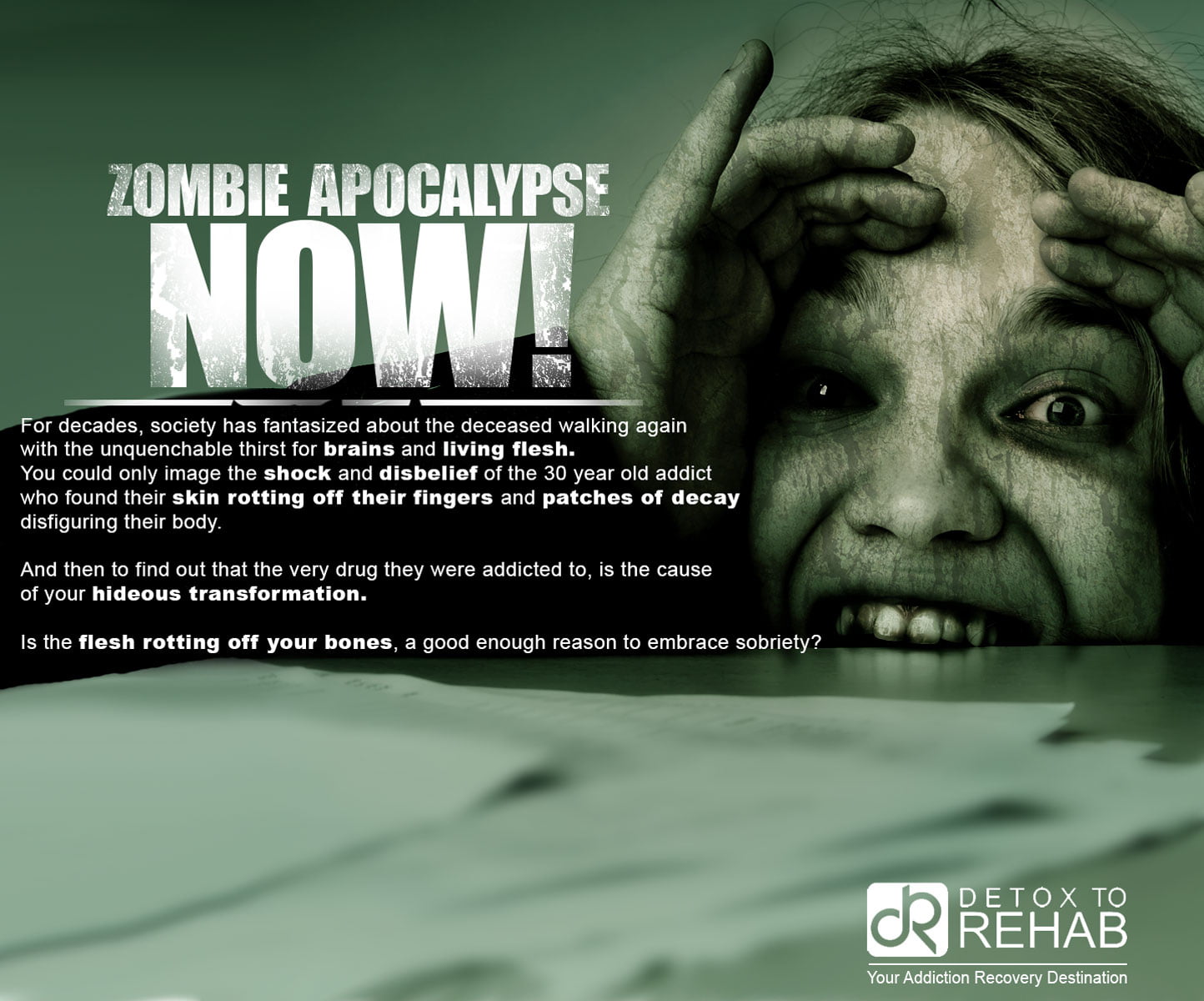For decades, society has fantasized about the deceased walking again with the unquenchable thirst for brains and living flesh. Movies, Tv shows, video games, songs, novels, and even zombie parades have entertained the masses with their decaying flesh deformities, rigid waltz of impending doom, and groans of hunger. You could only image the shock and disbelief of the 30 year old addict who found their skin rotting off their fingers and patches of decay disfiguring their body. And then to find out that the very drug they were addicted to, is the cause of your hideous transformation. Is the flesh rotting off your bones, a good enough reason to embrace sobriety?
What is Krokodil and Why is it Called the Zombie Drug?
Never has man seen such a devastating synthetic drug on the market such as this. Gasoline, paint thinner, Codeine, hydrochloric acid, iodine and red phosphorous from matchstick heads is the deadly brew that is cooked in kitchens, not laboratories, across continents. A dismal yellow liquid with an astringent stink is prized for its purities and injected into flesh for a transient opiate like high. Calling to heroin addicts across the nation, a dose of krokodil costs just a few dollars, compared to the $20 for a hit of heroin.
Alias’s of the Krokodil
- Krokodil
- Chlorocodide
- Desomorphine
- Zombie drug
- Russian Magic
- Cheornaya
- Himiya
Reported Health Hazards Due to Krokodil Injection Use:
- Blood vessel damage
- Open ulcers, gangrene, phlebitis
- Skin and soft tissue infections
- Skin grafts/surgery
- Limb amputations
- Pneumonia
- Blood poisoning
- Meningitis
- Rotting gums/tooth loss
- Blood-borne virus transmission (HIV/HCV due to needle sharing)
- Bone infections (osteomyelitis)
- Speech and motor skills impairment
- Memory loss and impaired concentration
- Liver and kidney damage
- Overdose
- Death
How is the Zombification Occurring?
The deadly tonic crafted from over the counter poisons is injected into the tissue of the user eating the body from the inside out, causing blood vessels to rupture and surrounding tissue to rigamortis and fester. Greenish and scaly skin pigments initially appear due to damaged blood vessels. The skin’s appearance is similar to a crocodile’s scaled and rugged exterior. Addicts pay dearly for the cheap high as krokodil destroys body tissue like battery acid erodes plastic, opening large sores that fester to the bone. The typical life span of an addict is just two or three years.
Patient Zero
In its modern form, krokodil emerged around 2002 from rural Russia as a cheap heroine substitute. Documented by TIMES, the video above contains graphic content of the cooking and use of Krokodil in Russia. Over the next ten or so years, it spread like a pandemic across the country’s poorest communities, picking up an estimated three million addicts.
Krokodil has also been reported Russia, Ukraine, Georgia, Kazakhstan, Germany, Norway, Arizona, Oklahoma, Illinois. More data is being collected and analyzed to determine the spread across the globe as this is a new drug.
“In October, a report published online in the American Journal of Medicine confirmed the case of a 30-year-old addict in Richmond Heights, Mo., whose finger “fell off” and whose skin began to rot after he began injecting krokodil.”
Zombie Withdrawals
The zombie drug spreads across continents preying on the addicts that are fending for heroin on a budget. 10x more addictive than heroin, Krokodil withdrawals are savage and life threatening. Where heroin withdrawals can cause sickness and pain for up to ten days, krokodil ravages the body with unbearable pain for a month.
Early symptoms of withdrawal include:
- Agitation
- Anxiety
- Muscle aches
- Increased tearing
- Insomnia
- Runny nose
- Sweating
Late symptoms of withdrawal include:
- Abdominal cramping
- Diarrhea
- Dilated pupils
- Goose bumps
- Nausea
- Vomiting
Professionals suggesting treatment, commented that this is the strongest level of addiction and the hardest to cure. If a person does manage to get clean from krokodil, they may be left with permanent damage like a speech impediment, amputated limbs, absent gaze, muscle damage, and erratic movements.








